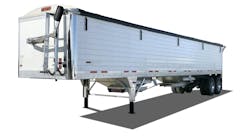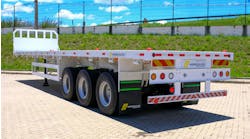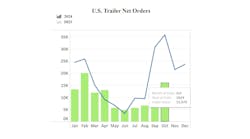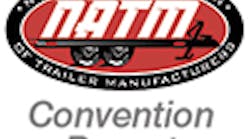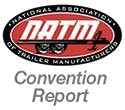Early Warning Reporting: It’s never too late to learn best practices or how to interact with NHTSA
Leo Akins believes a lot of companies in trailer manufacturing know something about Early Warning Reporting (EWR) and the National Highway Traffic Safety Administration (NHTSA), but every company has questions about them.
In “NHTSA Best Practices for the Trailer Manufacturing Industry,” Akins and Mike Becker tried to demystify them. Akins is director of quality, codes and standard, PDI, and dealer relations at Forest River Inc, a manufacturer of cargo trailers, RVs, and commercial vehicles in Elkhart, Indiana, and Becker is PDI quality assurance corporate compliance manager.
“That prompted NHTSA to enter into a consent order with us. That at first seemed like a really bad thing, but there are a lot of positives that come out of it. I’m the great example of a senior manager of a company that didn’t get myself fully involved with EWR reporting or TREAD. Now I’m one of the lead trainers of the company and making sure that whatever part of the programs that need to be addressed, we do it, from the president to the general manager and then down from there.”
Akins said the Vehicle Safety Act is a law applicable to manufacturers of motor vehicles and motor vehicle equipment (49 U.S.C. Chapter 301). Associated regulations establish requirements for: Federal Motor Vehicle Safety Standards (FMVSS); the recall of vehicles that contain safety-related defects or do not comply with FMVSS; and reporting information that may indicate a possible safety risk.
Registration is required for: all motor vehicle manufacturers; and equipment manufacturers to which an independent FMVSS applies (brake hoses, glazing, tires, seat belt assemblies, lamps, and reflectors). Manufacturers that are not required to register may still have an obligation to conduct a safety recall. Register with NHTSA within 30 days of start of production and any changes to business information.
The TREAD Act and the related EWR provisions require manufacturers to report information that may lead to the early detection of potential safety-related defects. The level of reporting detail is based on annual production.
He said people fear NHTSA, but it’s actually an organization that wants to work with trailer manufacturers.
“I’m not kidding,” he said. “You can call them. I have their names right in my cell phone. They will take the call. It’d be better to build a relationship and communicate with them than to not build that relationship and communicate with them.
“What’s most precious to us is the thing we’re doing. We will take care of our customers. We will address safety. But we also need to make sure we’re including the people who need to know what’s going on in that. If you think compliance is costly, try non-compliance. Whenever I’m in a board meeting I think, ‘I know this is going to cost a little bit, but it’s the right thing to do.’ ”
• External Communications Sent to More than One Entity Involving a Defect, 49 C.F.R. § 579.5.
Send NHTSA a copy of any communication about a defect that was sent to more than one manufacturer, customer, or dealer in the United States, whether or not the defect is safety-related. The term “defect” is defined broadly and does not need to be clearly safety related for the communication to be reportable under the regulation. Examples may include service bulletins, product advisories, notices, and other general communications to more than one entity. NHTSA reviews submissions to ensure the issue was appropriately handled via a “non-safety” field action, or whether there is actually a safety concern that warrants a recall. Submit copies of communications, with an index, within five business days of the end of the month in which the document was issued.
• Defect and Noncompliance Reporting, 49 C.F.R. 573.6.
Manufacturers are required to make safety decisions by undertaking a “good faith” investigation. A Part 573 Report is required for all vehicles transported beyond the direct control of the manufacturer. The root cause is not required to determine a safety defect exists. Reporting is required even if a remedy has not yet been developed.
• Defect and Noncompliance Reporting: The 5-Day Rule and Reports to NHTSA, 49 C.F.R. 573.6.
File the Defect or Noncompliance Information Report (the “Part 573 Report”) with NHTSA within five business days of the manufacturer deciding that a safety-related defect or noncompliance exists. Key content of 573 Report: vehicle population; description of the defect or noncompliance; description of the consequences of the defect or noncompliance; and chronology of key events leading to the decision to recall. The chronology should demonstrate: good faith investigation; ongoing progress; and no prolonged lapses in activity.
• Consumer Recall Notification, 49 C.F.R. Part 577.
Send customer notification letters within 60 days of filing the Part 573 Report. If a remedy is not available, send the interim notice and re-notify when parts are available. Send draft to NHTSA for approval before issuing customer letter. NHTSA proposal to allow notification by “electronic means” such as email, text messages, radio or television notifications, vehicle infotainment console messages, over-the-air alerts, social media, targeted online campaigns and phone calls, in addition to first-class mail. Notification by electronic means it must comply with the content requirements of the regulation. Alternatively, the electronic notification can provide a hyperlink to a notice that complies with the content requirements or, a representative copy along with instructions on how to determine if a particular vehicle is impacted.
• Safety and Quality Concerns Arising From Supplier Components, 49 C.F.R. 573.3.
Defects in original equipment may require action by the vehicle manufacturer. If the equipment is installed in the vehicles of only one manufacturer, either the supplier or the vehicle manufacturer can submit the Part 573 Report. If the equipment is installed in the vehicles of more than one manufacturer, the supplier and the vehicle manufacturer must each submit Part 573 Reports. Review supplier service bulletins to confirm there are no potential safety consequences that should be handled as a safety recall.
• Recordkeeping Requirements, 49 C.F.R. Part 576.
Manufacturers must retain records related to: defects or “malfunctions” that may be related to motor vehicle safety; and records underlying TREAD Act reporting. “Records” is defined broadly. Retention period will increase to 10 years from the date the record is generated or acquired.
Forest River’s best practices for the industry:
• Use the pre-delivery inspection process to identify potential safety and quality issues before the product is shipped.
This involves: a “second set of eyes”; tracking and monitoring manufacturing deviations and using data as a training opportunity (tracking by product, by deviation type, by plant, etc); and inspecting all production following a recall or issuing a service bulletin to confirm no further deviations.
• Use a multi-point system for identifying potential safety issues.
Internal data sources: warranty claims; customer complaints; legal; dealer technician input; and PDI information. External data sources: NHTSA VOQs; competitor OEM and supplier recalls and TSBs; supplier ECNs; and social media postings. Determine whether a safety defect exists by evaluating: severity of the risk; rate of failure; and detectability.
• Create and follow documented processes for conducting product investigations and making defect determinations.
Create processes and criteria that allow the company to determine when to open a product investigation. Ensure the roles of each person involved in the technical investigation and time tables for conducting the investigation and elevating the matter are defined. Develop an internal matrix or framework of issues and criteria that guides the decision of whether a defect is safety related or a noncompliance exists. Regularly review/refine these guidelines. Create decision making processes for initiating a recall or other field action.
• Maintain complete and well-documented investigation files.
Use a master list to track status of open and closed investigations and to sort by technical issue. Develop a more detailed investigation log to track each issue from inception to final action. Include a time line of all major events in the investigation process. Maintain records underlying each investigation, including technical data. Reference old/closed investigations if same or related issue arises in the future. Clearly document the company’s rationale for taking action or closing an investigation without any activity.
• Communicate with NHTSA on areas of uncertainty.
Communicate with NHTSA for input on whether a defect is safety related or there is a noncompliance. Contact NHTSA proactively and regularly.
• Create and follow documented processes for making defect determinations.
At the conclusion of the technical investigation, elevate the issue for decision of whether a safety recall is needed. Develop an internal matrix or framework of issues and criteria that guides the decision of whether a defect is safety related or a noncompliance exists. Regularly review/refine these guidelines. Create decision making processes for initiating a recall or other field action. Once a recall decision is made, trigger the company’s recall reporting process. ♦





